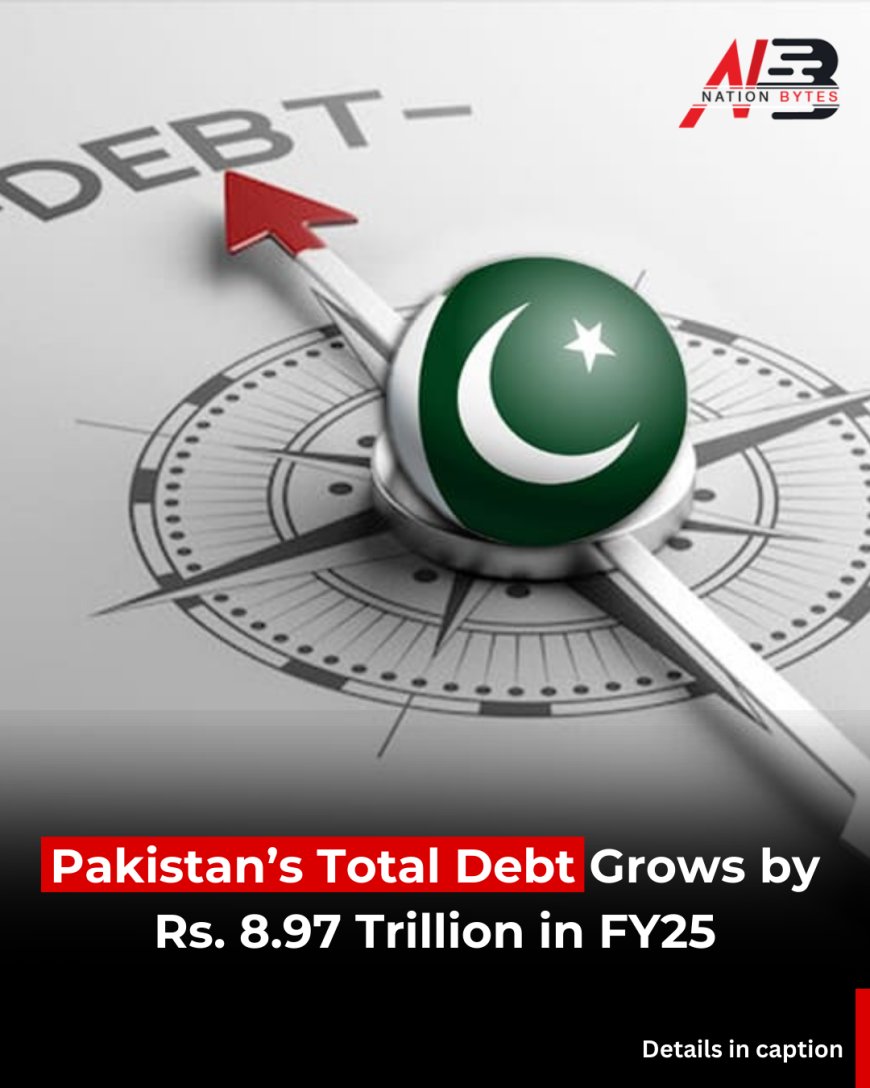Pakistan’s Total Debt Grows by Rs. 8.97 Trillion in FY25
Pakistan’s total debt has surged by Rs. 8.97 trillion in FY25, reaching record levels, according to the State Bank of Pakistan. Economists warn of a growing fiscal crisis and call for urgent reforms to stabilize the economy.

Pakistan is facing a growing economic challenge as its total debt has surged by Rs. 8.97 trillion during the first eight months of fiscal year 2024-25 (FY25). According to the State Bank of Pakistan (SBP), this sharp rise has pushed the country’s debt to record levels, raising concerns among economists, investors, and policymakers alike.
Where the Debt Increase Comes From
The SBP data shows that the debt growth comes from both domestic and foreign sources:
-
Domestic Debt: Up by Rs. 5.2 trillion due to the government borrowing heavily from local banks and financial institutions.
-
External Debt: Rose by Rs. 3.3 trillion, mostly from foreign loans, IMF disbursements, and the falling value of the Pakistani rupee.
As of February 2025, total public debt now stands at Rs. 72.5 trillion, putting pressure on the government’s budget and economic plans.
Why Pakistan’s Debt Is Rising
Several factors are driving this rapid increase:
-
Persistent Budget Deficits: The government spends more than it earns, forcing it to borrow.
-
Rupee Depreciation: A weaker rupee makes foreign loans more expensive.
-
Rising Interest Costs: Higher borrowing costs add to the debt burden.
-
Slow Revenue Growth: Tax collection is below expectations, limiting funds for spending.
-
Heavy Reliance on External Loans: Continuous borrowing from the IMF, World Bank, and friendly nations adds to the total debt.
How This Affects Pakistan’s Economy
Rising debt has serious consequences for the country:
-
Higher Inflation: Borrowing increases the money supply, driving prices up.
-
Debt Repayments Take Priority: A large part of the government’s revenue goes toward paying interest, leaving less for public projects.
-
Limited Development Spending: Infrastructure and social welfare programs may suffer.
-
Lower Investor Confidence: High debt and uncertainty can make investors hesitant.
-
Dependence on External Lenders: Heavy reliance on foreign loans may limit economic decision-making.
Government Response
The government has acknowledged these challenges and is taking steps to control the debt:
-
Implementing tax reforms to increase revenue
-
Reducing non-essential imports
-
Promoting exports to bring in more income
A senior official from the Ministry of Finance stated:
“We are working closely with the IMF and other international partners to stabilize the economy while managing our debt responsibly.”
Experts Speak
Dr. Saeed Khan, Economist:
“The Rs. 8.97 trillion rise in debt shows how urgent it is to implement fiscal reforms. Without better revenue collection and controlled borrowing, the economy could face bigger problems.”
Rashid Malik, Financial Analyst:
“High debt reduces the government’s flexibility. Policies should focus on sustainable growth and careful long-term planning.”
Final Thoughts
Pakistan’s rising debt in FY25 is a clear warning. Families, businesses, and policymakers are all affected when a country’s borrowing reaches such high levels.
From an EEAT perspective:
-
Expertise: Insights come from economists and SBP data.
-
Experience: Real-world effects on inflation, investment, and public spending.
-
Authoritativeness: Comments from recognized analysts and government officials.
-
Trustworthiness: Based on verified data and clear explanations.
Moving forward, Pakistan must borrow wisely, grow its revenue, and implement economic reforms to avoid further financial challenges. The goal is not just reducing debt but creating a stable economy that benefits everyone.
For more updates ,visit Nation bytes

 Ateeq Ur Rehman
Ateeq Ur Rehman